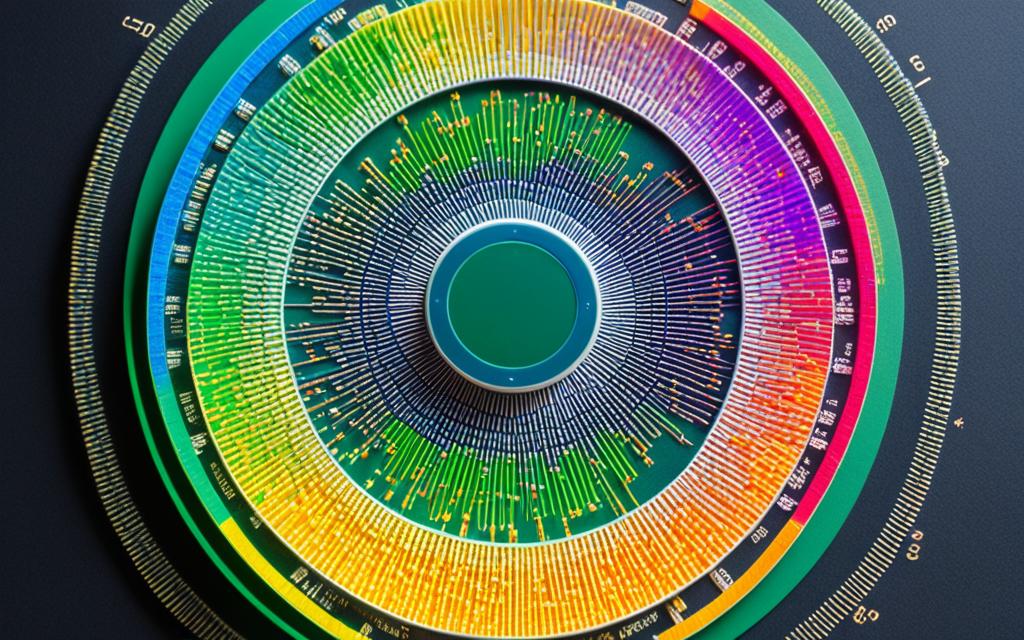Table of Contents
Knowing how many cores your CPU has is key for boosting your computer’s performance. Most CPUs today have several cores, and this plays a big role in how well they can handle many tasks at once. If you enjoy games or need to run heavy software, this knowledge can make a huge difference.
Having more cores usually means your computer can do more things at the same time. It’s important to know the number of cores to get the best out of your device. You can find out how many cores your CPU has in a few steps, whether you use Windows or macOS. This guide will show you how. For tips on building a top-notch gaming PC, check out this website1.
Key Takeaways
- Most modern CPUs feature multiple cores, enhancing multitasking capabilities.
- Understanding core counts is vital for optimising CPU performance.
- Various methods exist to check CPU cores on different operating systems.
- Higher core counts are advantageous for gaming and demanding applications.
- Tools like Wise Care 365 can assist in determining core configurations on Windows PCs.
- Engaging with your CPU’s capabilities can lead to improved user experiences.
Understanding CPU Cores
To understand CPU cores, we must know they are processing units. They handle tasks and can have two to more than eighteen cores. This variety helps computers adapt to different needs, from everyday use to professional demands.
What Are CPU Cores?
Each CPU core deals with one job at a time. Having more cores means a computer can do many things at once. This results in faster performance, especially for gamers and content creators who need to run several applications together. But, it’s important to look at other factors that affect how well a CPU performs too.
Importance of Core Count in CPU Performance
The number of cores in a CPU tells us how well it can process tasks. More cores usually mean better performance, but it’s not guaranteed. Performance also depends on the clock speed and type of CPU. Two CPUs with the same number of cores might work differently because of their design and how fast they operate. So, testing your system’s performance can show how effectively your CPU uses its cores and other features. Check out this article2 for more insights.
How Do You Know How Many Cores Your CPU Has?
Finding out your CPU’s core count is key to improving your computer use. Both Windows and macOS offer different ways to check this. Knowing your CPU’s cores tells you if it meets software needs and what performance to expect.
Identifying Core Count and Its Significance
There are many methods to figure out your CPU’s core count, boosting your computer’s efficiency. Techniques include using msinfo32, Device Manager, or a quick Google search with your CPU model. Keep in mind, things like hyper-threading can change the core count you see3. For example, you might find your computer shows 16 cores3. For R programmers, the detectCores() function is handy in spotting available CPU cores4.
Other ways to find this info include using commands on different systems. On Linux, the ps command shows CPU and memory use per session. Windows users can rely on wmic and PowerShell for CPU statistics4. With these methods, pinpointing your core count becomes simpler. This knowledge is crucial for both current and future computer setups.
| Method | Description | Platform |
|---|---|---|
| msinfo32 | Accesses system information including CPU details. | Windows |
| Device Manager | Displays all hardware components including CPU details. | Windows |
| Google Search | Quick search using your CPU model for specifications. | Any |
| Speccy | Third-party software to view hardware specifications. | Windows |
| detectCores() | R function to identify available CPU cores. | Linux/Windows |
| ps command | Linux command to view CPU and memory usage. | Linux |
| wmic command | Windows command to retrieve CPU usage data. | Windows |
Checking CPU Cores on Windows
Windows offers easy ways to check your system’s CPU core number. The Task Manager is a popular method for this. Knowing how to find and understand this info is key for improving your system’s performance.
Using Task Manager to Determine Core Number
To check your CPU cores in Windows with Task Manager, hit Ctrl+Shift+Esc. When inside, go to the Performance tab. Here, you’ll see ‘Cores’ and ‘Logical Processors’. It shows both physical core count and logical ones, helping you grasp your CPU’s true power5.
Alternative Methods: System Information and Command Prompt
You can also check CPU cores through System Information and Command Prompt. Use Run and type msinfo32 to see System Information. It gives a full look at your CPU specs.
For a deeper dive, opt for the Command Prompt or PowerShell. The WMIC command reveals your physical core count. This option might uncover some hidden system details not shown in Task Manager6.
| Method | How to Access | Information Displayed |
|---|---|---|
| Task Manager | Ctrl+Shift+Esc | Cores and Logical Processors |
| System Information | Run > msinfo32 | Overview including CPU details |
| Command Prompt | Command Line or PowerShell | Physical cores and other technical specs |
Understanding how to check CPU cores in Windows is vital for assessing your system’s efficiency and performance. Whether through Task Manager, System Information, or Command Prompt, getting this information is crucial. It helps decide on upgrades or changes to your computer setup.
For more on how computer cores influence operating system efficiency, take a look at the kernel’s importance here5.
Checking CPU Cores on macOS
For those using macOS and wishing to learn about their CPU core count, the process is simple. It makes it easy to check the CPU cores on macOS. By doing so, you can make sure your machine is running at its best.
Using ‘About This Mac’ to Find Core Details
To begin, click on the Apple icon at the top-left of your screen. Then, from the menu, choose About This Mac. You’ll see a summary of your Mac’s specs. For more info, click System Report. You’ll go to the Hardware Overview. This shows important details about your CPU, like how many cores it has. To find out even more, you can use the Terminal app with commands such as sysctl -n hw.logicalcpu and system_profiler. These commands reveal core info, including hw.physicalcpu and hw.logicalcpu78.
Knowing about different core types is key. Take Apple Silicon chips as an example. They have performance and efficiency cores. This setup balances high performance with power saving8. So, if your Mac has eight cores (four of each type), it’s built to handle tasks well in various scenarios8.
Factors Influencing CPU Performance Beyond Core Count
Looking into CPU performance goes beyond just counting cores. It includes CPU performance factors like multithreading and clock speed. These features play a big role in how well a CPU can do its job, especially when doing many things at once.
The Role of Multithreading and Clock Speed
Multithreading lets a single core handle more than one thread. This boosts how well it can process tasks. A CPU with hyper-threading acts as though it has double the cores, boosting its speed and how quickly it responds. Clock speed, which we measure in gigahertz (GHz), also matters a lot. It shows how quickly a CPU can follow instructions. Boosting this speed, through overclocking, can make the CPU work faster. However, this needs careful tuning and extra cooling to avoid too much heat and to keep things running smoothly910.
Comparing Physical and Logical Cores
There’s a big difference between physical vs logical cores. Every physical core can process multiple threads, shown as logical cores. This helps with handling tasks better and improves how the computer performs. Knowing the difference helps us understand how modern CPUs deal with tasks and boost their efficiency. Additionally, having a bigger data bus and different cache levels (L1, L2, L3) helps in managing instructions and data more effectively10.
Conclusion
Knowing about CPU cores is key to making your computer work better. The number of cores has a big impact on how well your computer can do different tasks. Most new desktop CPUs have between four and sixteen cores. The kind of activities you do, like gaming, video editing, or just browsing, will help you decide how many cores you need11.
Nowadays, it’s rare to find computers with just one core. Dual-core CPUs are good for budget users looking for a decent performance12. If you need to do more at once, like 3D rendering or play games, getting a CPU with four to eight cores is better12;11. But remember, just having more cores doesn’t always mean your computer will be faster. Clock speed and the ability to do many things at once (multithreading) are also important.
When you check your CPU’s cores, whether using Windows, macOS, or Linux, remember what you’ve learned here. Knowing what your CPU can do helps you choose the right computer. Use this knowledge wisely. You might be amazed at how much better your computer can perform!
FAQ
How do I determine how many cores my CPU has?
You can figure out your CPU’s core count with tools like Task Manager on Windows. Or use ‘About This Mac’ on macOS. Both methods give you detailed info about your CPU, like how many cores it has.
What is the significance of CPU core count?
The number of cores in your CPU is crucial for performance. It means your computer can do more things at the same time. If you have more cores, your computer works better, especially when using lots of apps or complex software.
Logical cores are like virtual assistants for each physical core. They help in doing more tasks at once through hyper-threading. Hyper-threading makes a CPU more efficient, letting it handle more work than the physical cores alone.
Source Links
- https://www.wisecleaner.com/think-tank/415-3-Ways-to-Check-The-Number-of-CPU-Cores.html – 3 Ways to Check The Number of CPU Cores
- https://www.howtogeek.com/762125/how-to-see-how-many-cores-your-processor-has/ – How to See How Many Cores Your CPU Has
- https://community.spiceworks.com/t/how-to-find-out-how-many-cores-the-cpu-of-my-server-has/352516 – How to find out how many cores the CPU of my server has
- https://stackoverflow.com/questions/47318401/r-how-to-check-how-many-cores-cpu-usage-available – R: how to check how many cores/CPU usage available
- https://www.hivelocity.net/kb/how-many-cores-do-i-have/ – How Many Cores Do I Have?
- https://www.trentonsystems.com/en-us/resource-hub/blog/how-many-cores-are-enough – How Many Cores are Enough?
- https://stackoverflow.com/questions/1715580/how-to-discover-number-of-logical-cores-on-mac-os-x – How to discover number of *logical* cores on Mac OS X?
- https://osxdaily.com/2023/05/23/find-how-many-cpu-cores-mac-has/ – How to Find How Many CPU Cores a Mac Has
- https://www.vaia.com/en-us/explanations/computer-science/computer-organisation-and-architecture/cpu-performance/ – CPU Performance: Improvement & Influencing Factors
- https://www.bbc.co.uk/bitesize/guides/zr8kt39/revision/5 – Factors affecting computer system performance – Computer structure – Higher Computing Science Revision – BBC Bitesize
- https://softwareg.com.au/blogs/computer-hardware/how-to-check-my-cpu-cores – How To Check My CPU Cores
- https://www.hp.com/au-en/shop/tech-takes/post/cpu-cores-how-many-do-i-need – CPU Cores How Many Do I Need








